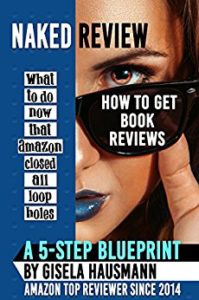 by Gisela Hausmann
by Gisela Hausmann
One common myth says indie authors need only get a few/some/many reviews from friends and acquaintances, then buy an online promotion and their book will (probably) take off.
As an Amazon reviewer since 2012 and a top reviewer since 2014, I can contribute some factual information.
In 2014 I reviewed 75 items on Amazon, including 45 books penned by indie authors.
Combined, these 45 books received 5,448 reviews.
You may raise an eyebrow, but it’s true.
Four books received only one single review (mine),
Six of the 45 books received more than 100 reviews.
Eleven of the 45 books (including the previously mentioned four) have received fewer than a half-dozen reviews since 2014.
Ponder this fact for a second: almost 25% of all indie author books I read and reviewed in 2014 have received fewer than a half-dozen reviews in more than two years.
Twenty-eight of the 45 books received a dozen or more reviews but fewer than 100.
The six books with more than 100 reviews received 186, 217, 234, 375, 419, and 872 reviews, respectively.
The astonishing surprise: The book that received the most reviews is a book that I awarded only a two-star review. Obviously, the secret to success is not all about writing the best book.
I decided to check out this book after I read about it in an online article. Then (in 2014), the book had barely more than 100 reviews. I thought posting my review would make a difference and encourage others to think twice about spending $2.99 for this particular book.
Amazon still lists this book as a bestseller with 2,329 reviews.
How does the author do it?
Probably he grew a huge email list. Occasionally, he runs promotions (I have seen one 99-cent promo and three promos at full price). Most importantly, he succeeds in getting influential journalists and top bloggers to talk about his book. Not only did I learn about the book from an article, but he has been in the news–featured in seven articles–since January 2017, in only six weeks. Even now, he does not stop promoting his book in media outlets. Altogether, 86 articles have featured him and his book.
What is to be learned from this information?
Getting reviews from friends, acquaintances, and colleagues does NOT do the trick.
Remember that four of the books I reviewed were not reviewed by anyone else, in more than 2 years…
even though all four authors networked in Facebook groups and tweeted their heart’s out.
According to Pew Research, in 2016:
- 68% of all online U.S. adults used Facebook (What about the other 32%?)
- 32% of all online U.S. adults used Instagram
- 29% of all online U.S. adults used Linkedin
- 26% of all online U.S. adults used Pinterest
- 21% of all online U.S. adults used Twitter
Only 76% of the U.S. adults who used Facebook logged in daily
(that’s only 51% of all online U.S. adults)
- only 51% of the U.S. adults who used Instagram logged in daily
- only 42% of the U.S. adults who used Linkedin logged in daily
- only 25% of the U.S. adults who used Pinterest logged in daily
- only 18% of the U.S. adults who used Twitter logged in daily
Therefore, to really get your book out, you and your book need to have a presence in many venues.
Routinely, financial advisers preach, “Diversify your portfolio!”
The same advice applies to book marketing,
 10 ways to get your book seen, bought, and reviewed:
10 ways to get your book seen, bought, and reviewed:
- Join a real “live” book club, e.g. a meet-up group or book club at your local library
- Join online book groups (Facebook, GoodReads, etc.)
- Arrange for book signings at independent book stores
- Try to get gigs at local library events (about 20% of all U.S. libraries host local author events once or twice per year)
- Offer to guest blog
- Pitch your local TV station
- Pitch magazines (print and online)
- Pitch bloggers who don’t blog about books. (Remember: you want to be found and noticed by new and different audiences)
- Pitch radio hosts and podcasters
- Throw a private book party at a bar or a coffee house, or team up with other local authors to throw a party together
Naturally, pursuing a minimum of five or six of these options requires more work than networking on Facebook (in your pajamas), but it helps to reach many tens of thousands of people who otherwise never would have heard about you and your book, as shown by Pew Research’s data.
Many indie authors spend so much time on Facebook that they could pitch two or three publications every day, in half the time they spend networking on Facebook.
Best of all, media coverage doesn’t go away. In contrast to online promotions, media coverage stays “live” and will promote you and your book—forever!
When doing the research for this article, I looked up a bestselling author’s name and found the seven articles written about him and his book on Google, in less than two seconds. Even potential readers who have never heard of the author and search using different search terms on Google will find the book, by accident, like I did.
Summing it up: every author needs starter reviews, but the majority of reviews will come by themselves once you expose your book to many audiences.
Gisela Hausmann is a 29-year publishing-industry veteran who self-published her first book in 1988. Her work as an Amazon ecommerce review expert has been featured on Bloomberg (podcast) and on NBC News (blog); her work as an email evangelist was featured in SUCCESS and in Entrepreneur.
